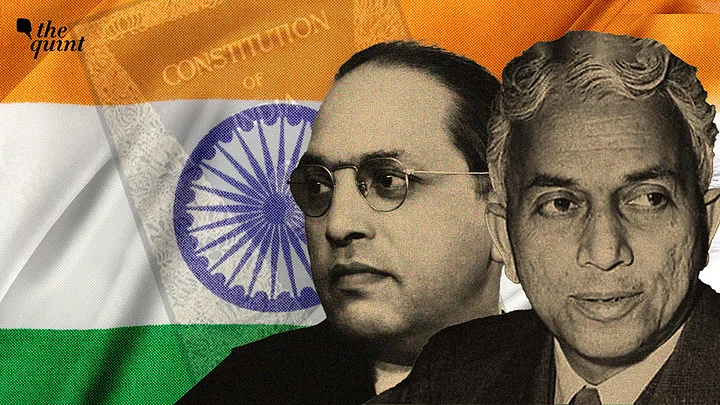A fitting tribute to BR Ambedkar on his 133rd Jayanti is to remember his dream of establishing the country as the “United States of India.” He proposed the idea in March 1947 to one of the subcommittees of India’s Constituent Assembly.
But a few months later, when he was appointed the Chairman of the Constitution’s Drafting Committee, he began to prop up the Congress party’s vision rather than pursuing his own. I have written before about Ambedkar’s scheme and how it was never even brought up for discussion inside the Assembly.
Ambedkar wasn’t alone in this vision. His predecessor, Sir Benegal Narsing Rau, who wrote the first draft of the Constitution, also proposed a federation under the title "United States of India.”
Rau’s proposal was made more than a year earlier in January 1946 when he was still a bureaucrat in the British government. He was later appointed the Constitutional Adviser to the Assembly and worked closely with Jawaharlal Nehru and others in the making of the Constitution.
A Constitutional Vision of India
Ambedkar and Rau were both visionaries. They saw that a united India would be stronger and more prosperous than a divided India.
Rau was a renowned constitutionalist. “From 1935 onwards, Rau was at the center of the major constitutional developments in India. By 1946, he was one of the more sought after constitutional experts by all the major Indian political parties and the British government,” says his biographer Arvind Elangovan.
After graduating from the University of Cambridge—where Nehru reportedly admired his scholarship—Rau joined the Indian Civil Services and quickly rose to an appointment in the Governor-General’s Secretariat. Later in life, Rau represented India at the United Nations and served as a judge at the International Court of Justice.
It was Rau who had convinced the British to transfer real authority to the Indians under the Government of India Act of 1935. That Act allowed Indians to form their own provincial governments for the first time, but the British were reluctant to give them any sovereign authority. Rau argued that the 1935 Act had to be treated as a constitution, and not just legislation. The same Act later became the basis of India’s own constitution.
‘United States of India’ Was Conceived To Counter British Dominance
Rau made his “United States of India” proposal in the last hours of despondency when the Muslim League and Congress had failed to agree on any type of constitution for Independent India. In 1946, India faced a bizarre and disgraceful situation. For four years, a foreign power was willing to grant her independence but wasn’t able to do so because the Indians wouldn’t agree on a system of government.
He proposed organising the country as a federation of provincial governments, each with the right of self-governance but not self-determination. His “United States of India” consisted of three types of territories: British Indian provinces, Frontier provinces, and the Princely States and tribal areas. The Frontier provinces corresponded to the areas that the Muslim League sought as Pakistan.
Rau gave the provinces autonomy in local matters, but not in defence, external affairs, communications, and related finances. His scheme gave the British and Frontier provinces equal representation in the Union Executive and Legislature.
“The essence of the scheme,” Rau wrote, “is that while domination of one community by another is to be prevented, the unity of India is to be preserved for purposes equally beneficial to all. ”There was to be one federal legislature, but Rau’s plan allowed it to sit in parts in the three territories, so “the functions in respect of each group may be discharged... by the members of that group alone.”
The executive branch of his “United States of India” was organised as follows: “The executive authority of the Federation is to be exercised by a Governor-General and there is to be a Privy Council of India to aid and advise him... There shall be separate Executive Committees of the Privy Council for each of the three groups.”
Why Ambedkar’s Vision Remained As Good as a Concept
Ambedkar’s "United States of India” took a similar approach. His plan’s emphasis was on the executive branch. He argued that a Prime Minister and a Cabinet appointed by the majority in the Parliament were unsuited to India’s diversity.
“The British type of Executive will be full of menace to the life, liberty, and pursuit of happiness for India’s minorities,” said Ambedkar. His scheme organised the executive branch in such a way that it was not a committee of the majority party, left to its mercy. “The Executive should be non-parliamentary in the sense that it shall not be removable,” he wrote.
Sadly, Ambedkar’s and Rau’s visionary proposals were both ignored. Rau’s “United States of India” died a quick death in 1946 when the Muslims voted overwhelmingly to support Mohammad Ali Jinnah and the creation of Pakistan. This also ended any hope for Ambedkar’s proposal, because the Hindu majority was no longer interested in sharing power with India’s minorities.
But India still searches for ways to unite. It’s time that Ambedkar and Rau’s original proposals are given their due respect and consideration.
(The author is the Founder and the CEO of the Divya Himachal group and author of ‘Why India Needs the Presidential System’. He can be reached @BhanuDhamija. This is a personal blog and the views expressed above are the author’s own. The Quint neither endorses nor is responsible for the same.)
